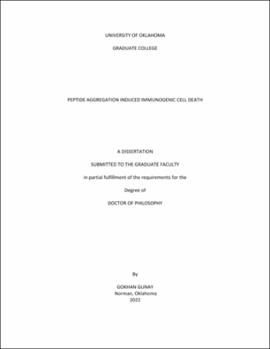| dc.description.abstract | Cell death is an inevitable biological outcome, every living thing dies. However, how cells die is an important question and ultimately is decisive in homeostasis and disease progression. Immune system is in the center of health and disease conditions and its proper activation is critical for life. In case of infection/cancer, immune system recognizes and kills the infected/cancerous cells. Proper recognition and activation solely depend on the activation of specialized cells called antigen presenting cells (APCs). These cells present components of the non-host called antigens and directs the immune system towards it. Evolutionary conserved receptors on these cells are specialized to recognize several patterns and motifs. These motifs are called pathogen associated molecular patterns (PAMPs) and damage associated molecular patterns (DAMPs) exogeneous and endogenous factors, respectively. DAMPs gained increasing attention since the initial proposal of the Danger Theory, which proposes that the immune system responds to danger. One of the most infamous examples of DAMP release in disease conditions is the neurodegenerative disorders. Aggregating peptides such as amyloid beta (A), damage the cell membranes of healthy cells leading to DAMP release and increased neuroinflammation. While resulting in an ultimately undesired disease progression, membrane damaging role of aggregating proteins can be harnessed for immunotherapy applications for the induction of ICD and DAMP release. However, utilization of peptides such as A are difficult to synthesize, characterize and lead to uncontrollable heterogeneous structures. Biologically, antibodies form against A, drastically limiting their utilization for immunotherapy applications. Therefore, tools that are easy to synthesize, characterize and mimic the functionality of membrane damage and DAMP release without inducing serious side effects have high potential to be utilized in multiple different immunotherapy applications.
In this dissertation, an engineering platform called co-assembly of oppositely charged peptides (CoOP) and its applications in ICD and DAMP release is studied. Inspired by the aggregation induced-cell membrane damage of A, we introduced two oppositely charged peptide pairs called EFFIIE and KFFIIK forming [II] peptide. We first studied the cellular consequences of [II] peptide and found that [II] peptide aggregation induces ICD and DAMP release in several different healthy and cancer cell lines. Leveraging the DAMP-releasing effect of [II] peptide, we developed a quadrivalent influenza vaccine and found significantly elevated IgG1 and IgG2a responses, corresponding to the engagement of Th2 and Th1 immunity, respectively. Next, we showed the controllability of [II] peptide aggregation, which ultimately leads to control over DAMP release and the immunogenicity of dying cells. Different aggregation profiles lead to differential membrane damage and DAMP release profiles. When cells were treated with [II] peptide at different aggregation states, the dying cells led to protection in a prophylactic vaccination model against breast cancer, and differences in aggregation status led to differential protection levels. Lastly, we used [II] peptide aggregation model in a three-dimensional spheroid model of breast cancer and compared this activity with known chemotherapeutics. [II] peptide treated spheroids displayed superior DAMP release and dendritic cell activation.
Successful stimulation of ICD and DAMP release is a fundamental and challenging strategy to induce robust antigen-specific immune response. [II] peptide aggregation is a controllable tool that can be used as an adjuvant in vaccination strategies as well as a treatment modality against cancer. | en_US |

